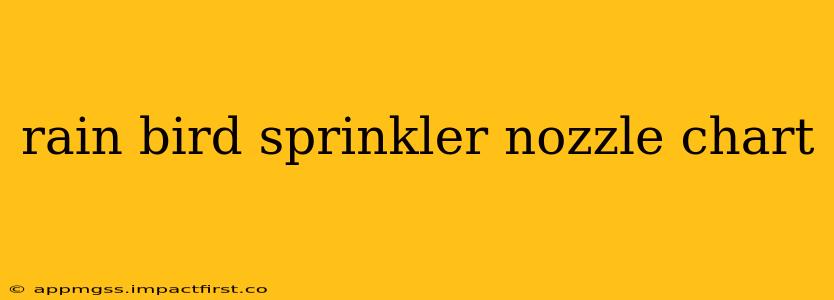Choosing the right sprinkler nozzle is crucial for efficient and effective irrigation. A Rain Bird sprinkler nozzle chart helps you select the perfect nozzle based on your specific landscape needs. This guide will walk you through understanding Rain Bird's nozzle offerings, interpreting their charts, and selecting the best fit for your lawn and garden.
Rain Bird, a leading name in irrigation, offers a wide variety of nozzles, each designed for different spray patterns, throw distances, and precipitation rates. Understanding these variations is key to optimizing your watering system and conserving water.
What is a Rain Bird Sprinkler Nozzle Chart?
A Rain Bird sprinkler nozzle chart is a visual reference tool that shows the various sprinkler nozzle options available. This chart typically lists key specifications for each nozzle, such as:
- Nozzle Type: This indicates the spray pattern (e.g., rotary, spray, stream).
- Arc: The angle of the spray pattern (e.g., 360°, 180°, 90°).
- Radius/Throw: The distance the water sprays from the nozzle.
- Precipitation Rate: The amount of water applied per hour.
- Nozzle Size: This helps you determine the flow rate and water pressure compatibility.
How to Use a Rain Bird Sprinkler Nozzle Chart
Using a Rain Bird sprinkler nozzle chart is relatively straightforward. Begin by identifying your needs:
-
Determine your spray pattern requirements: Do you need a full circle (360°), a half circle (180°), or a quarter circle (90°)? This depends on the shape of your garden beds or lawn areas.
-
Measure the throw distance required: How far do you need the water to reach? This will help you choose a nozzle with an appropriate radius.
-
Calculate your water pressure: Consult your water meter or pressure gauge to determine the water pressure in your system. This is crucial for choosing a nozzle that will operate efficiently at your pressure.
-
Consider your precipitation rate: You want enough water to adequately irrigate your plants without overwatering. The chart helps determine the rate of water distribution for different nozzles.
-
Locate the appropriate nozzle: Once you've determined these key factors, refer to the Rain Bird sprinkler nozzle chart to find a nozzle that meets your specifications.
What Types of Rain Bird Sprinkler Nozzles Are There?
Rain Bird offers several nozzle types, each serving a different purpose:
-
Rotary Nozzles: These nozzles rotate to distribute water over a large area, making them ideal for lawns and open spaces. They're efficient at covering significant distances.
-
Spray Nozzles: Spray nozzles offer a gentle, even spray, suitable for delicate plants or areas requiring a finer mist. They cover smaller areas compared to rotary nozzles.
-
Stream Nozzles: Stream nozzles deliver a concentrated stream of water, perfect for targeted watering of specific plants or areas.
-
MP Rotator Nozzles: These low-flow, high-efficiency nozzles are designed to deliver a precise, uniform application of water. They are very efficient, reducing water waste.
What is the difference between a rotor and spray nozzle?
This is a frequently asked question, and the difference boils down to the type of spray and coverage area. Rotary nozzles (rotors) rotate to cover a large, circular area, while spray nozzles provide a fixed spray pattern with a shorter radius. Rotors are better for larger areas and lawns, while sprays are suited for smaller, more delicate areas needing precise watering.
How do I calculate the right precipitation rate for my sprinkler system?
Calculating the appropriate precipitation rate is crucial for efficient watering. It depends on several factors, including the type of soil, plant type, and climate. Rain Bird's documentation and online resources offer calculators and guidelines to help determine this crucial parameter. It’s important to not overwater, as this can lead to root rot and wasted water. Underwatering can obviously harm plants as well. Finding the sweet spot is key.
How often should I check my Rain Bird sprinkler nozzles?
Regularly checking your nozzles is essential for maintaining optimal performance and water conservation. Inspect your nozzles at least once a month for clogs, debris, or damage. Clean or replace any malfunctioning nozzles promptly.
Conclusion
Understanding Rain Bird sprinkler nozzle charts and their specifications empowers you to design an efficient and effective irrigation system. By carefully selecting the right nozzles, you can ensure that your plants receive adequate water while conserving this precious resource. Remember to regularly maintain your system to ensure long-term performance and water savings. Always consult the official Rain Bird documentation and resources for the most up-to-date and detailed information.
